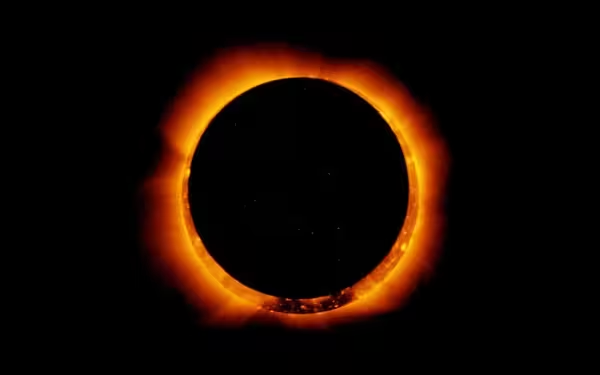Sunday, October 6, 2024 06:32 AM
October Solar Eclipse: Witness the Rare Ring of Fire
- October solar eclipse creates a rare 'ring of fire'.
- Visible in select regions of South America.
- Proper eye protection is essential for viewing.
 Image Credits: geo
Image Credits: geoOctober's solar eclipse will create a rare 'ring of fire', visible in select South American regions. Ensure safe viewing practices.
In a spectacular celestial event, October will witness a solar eclipse that promises to create a rare "ring of fire". This phenomenon occurs when the moon aligns perfectly between the sun and the Earth, but does not completely cover the sun's light. As a result, viewers will see a bright ring surrounding the moon, resembling a fiery halo. This event is particularly exciting as it follows the total solar eclipse that captivated many just six months ago.
However, not everyone will have the opportunity to experience this breathtaking sight. The "ring of fire" will only be visible in select regions of South America, specifically during the night between Wednesday and Thursday. According to experts, the moon will be positioned farther from the Earth than usual, allowing observers in parts of Chile and Argentina to witness what Diego Hernandez, head of scientific dissemination at the Buenos Aires Planetarium, describes as "a kind of ring of light coming from the Sun". Before and after the ring appears, viewers will also see a "crescent sun" as the moon moves in front of the sun.
The path of the solar eclipse will begin in the North Pacific, traverse the Andes and Patagonia regions, and conclude in the Atlantic Ocean. This event is expected to last over three hours, from 1700 to around 2030 GMT. However, the actual "ring of fire" will only be visible for a few minutes, specifically around 1845 GMT, according to the IMCCE institute of France's Paris Observatory.
For those who are not in the direct path of the eclipse, a partial eclipse will be observable from various countries, including Bolivia, Peru, Paraguay, Uruguay, parts of Brazil, Mexico, New Zealand, and several islands in the Pacific and Atlantic oceans. This means that while the full spectacle may be limited to a few, many will still have the chance to see a partial eclipse.
It is crucial to note that viewing a solar eclipse without proper eye protection can lead to serious and irreversible damage to the retina. Ordinary sunglasses are not sufficient to protect your eyes during this event. The safest methods for viewing the eclipse include using certified special eclipse glasses or observing the eclipse indirectly through a pinhole in a cardboard sheet, which projects the image of the eclipsed sun onto another sheet.
Looking ahead, the next partial solar eclipse is scheduled for March 29, 2025, and will primarily be visible from western North America, Europe, and northwest Africa. As we prepare for this October's solar eclipse, it serves as a reminder of the wonders of our universe and the importance of safe viewing practices. Whether you are in the path of the "ring of fire" or watching from afar, this event is a unique opportunity to connect with the cosmos and appreciate the beauty of our solar system.













